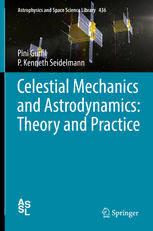
Celestial Mechanics and Astrodynamics: Theory and Practice PDF
Preview Celestial Mechanics and Astrodynamics: Theory and Practice
Astrophysics and Space Science Library 436 Pini Gurfi l P. Kenneth Seidelmann Celestial Mechanics and Astrodynamics: Theory and Practice Celestial Mechanics and Astrodynamics: Theory and Practice Astrophysics and Space Science Library EDITORIAL BOARD Chairman W.B.BURTON,NationalRadioAstronomyObservatory,Charlottesville, Virginia,U.S.A.([email protected]);UniversityofLeiden,TheNetherlands ([email protected]) F.BERTOLA,UniversityofPadua,Italy C.J.CESARSKY,CommissionforAtomicEnergy,Saclay,France P.EHRENFREUND,LeidenUniversity,TheNetherlands O.ENGVOLD,UniversityofOslo,Norway A.HECK,StrasbourgAstronomicalObservatory,France E.P.J.VANDENHEUVEL,UniversityofAmsterdam,TheNetherlands V.M.KASPI,McGillUniversity,Montreal,Canada J.M.E.KUIJPERS,UniversityofNijmegen,TheNetherlands H.VANDERLAAN,UniversityofUtrecht,TheNetherlands P.G.MURDIN,InstituteofAstronomy,Cambridge,UK B.V.SOMOV,AstronomicalInstitute,MoscowStateUniversity,Russia R.A.SUNYAEV,SpaceResearchInstitute,Moscow,Russia Moreinformationaboutthisseriesathttp://www.springer.com/series/5664 Pini Gurfil • P. Kenneth Seidelmann Celestial Mechanics and Astrodynamics: Theory and Practice 123 PiniGurfil P.KennethSeidelmann FacultyofAerospaceEngineering DepartmentofAstronomy Technion-IsraelInstituteofTechnology TheUniversityofVirginia Haifa,Israel Charlottesville,USA ISSN0067-0057 ISSN2214-7985 (electronic) AstrophysicsandSpaceScienceLibrary ISBN978-3-662-50368-3 ISBN978-3-662-50370-6 (eBook) DOI10.1007/978-3-662-50370-6 LibraryofCongressControlNumber:2016943837 ©Springer-VerlagBerlinHeidelberg2016 Thisworkissubjecttocopyright.AllrightsarereservedbythePublisher,whetherthewholeorpartof thematerialisconcerned,specificallytherightsoftranslation,reprinting,reuseofillustrations,recitation, broadcasting,reproductiononmicrofilmsorinanyotherphysicalway,andtransmissionorinformation storageandretrieval,electronicadaptation,computersoftware,orbysimilarordissimilarmethodology nowknownorhereafterdeveloped. Theuseofgeneraldescriptivenames,registerednames,trademarks,servicemarks,etc.inthispublication doesnotimply,evenintheabsenceofaspecificstatement,thatsuchnamesareexemptfromtherelevant protectivelawsandregulationsandthereforefreeforgeneraluse. Thepublisher,theauthorsandtheeditorsaresafetoassumethattheadviceandinformationinthisbook arebelievedtobetrueandaccurateatthedateofpublication.Neitherthepublishernortheauthorsor theeditorsgiveawarranty,expressorimplied,withrespecttothematerialcontainedhereinorforany errorsoromissionsthatmayhavebeenmade. Coverillustration: Technion’sSpaceAutonomousMissionforSwarmingandGeo-locatingNanosatel- lites(SAMSON).Credit:AsherSpaceResearchInstitute,Technion Printedonacid-freepaper ThisSpringerimprintispublishedbySpringerNature TheregisteredcompanyisSpringer-VerlagGmbHBerlinHeidelberg Idedicatethisbooktomychildren,Eytam, Oshri,and Ohav,andto myparents,Arieand Sara. PiniGurfil Thisbookisdedicatedto BobbieSeidelmann andourfamily,Holly,Kent, Jutta,Alan, Karen, andSarah. P.Kenneth Seidelmann Alsowededicatethebooktothescientists thatpreceded usand taught,mentored, and inspiredus. Foreword The early contributions to artificial satellite orbit theory were mostly made by the celestial mechanicians, e.g., Brouwer, Garfinkel, Vinti and Kozai. Then, as aerospace engineering curricula emerged, their astrodynamics graduates began to make contributions. Most of the recent astrodynamics books have been written byengineeringgraduates.Thisbook,co-authoredbya celestialmechanician,Ken Seidelmann, and an astrodynamicist, Pini Gurfil, is a welcome addition to the aerospacecommunityasitmergesthetwobackgrounds. Chapter1beginswithashorthistoryofcelestialmechanicsandthentransitions tointroductionstosomeofthekeytopicscoveredinthebook.Topicsincludedthat arenotusuallyseeninastrodynamicsbooksarestability,chaos,Poincarésections, KAM (Kolmogorov-Arnold-Moser) theory, and observation systems. Chapter 2 covers the basic math and physics concepts needed for the subjects in the book. Chapter3providesanexcellentdiscussionofcoordinatesystemsandintroducesrel- ativity,asubjectnotusuallyincludedinastrodynamicsbooksbutcertainlypresent incelestialmechanics,e.g.,theprecessionofMercury’sperihelion.Chapters4and5 provideathoroughdiscussionofthecentralforceandtwo-bodyproblems.Included isasectiononEinstein’smodificationoftheorbitequation.ThefocusofChap.6is initialorbitdetermination.Chapter7providesathoroughdiscussionoftheN-body problem and the integrals associated with this problem. Chapter 8 then addresses the special case of the circular restricted 3-bodyproblem(CR3BP). The coverage oftheCR3BPismorecomprehensivethanfoundinmostastrodynamicsbooksand includesadiscussionoffamiliesofperiodicorbits.Chapter9isanintroductionto numericalproceduresusedinastrodynamicsandcelestialmechanics.Thischapter isnotacomprehensivecoverageandcomparisonofnumericalintegrationmethods but an introduction to the methods needed to understand numerical methods and errorcomputation. Chapter 10 begins a group of five chapters that this writer considers very important for astrodynamics and celestial mechanics but is often not found in astrodynamicsbooks.Ibelievethatthemotionundertheinfluenceofconservative perturbations, those derivable from a potential, is best addressed and understood vii viii Foreword using Hamiltonian mechanicsand perturbationmethodssuch as Lie series. Chap- ter 10 discusses the basics of Hamiltonian mechanics, canonical transformations, generating functions, and Jacobi’s theorem and applies these to the two-body problem. The focus of Chap. 11 is perturbation methods, and it begins with an excellentdiscussionofthevariationofparameters(VOP),whichleadstoLagrange’s planetary equations. Then, with the perturbationsexpressed as specific disturbing accelerations instead of the accelerations obtained from a potential, Gauss’ vari- ational equations are derived for the accelerations in the radial, transverse, and orbit normal directions and the tangential, normal, and orbit normal directions. IncludedisadiscussionofLagrangebrackets,whichareneededfortheVOP.Also inthischapteristhepresentationoftheKustaanheimo-Stiefelvariables.Usingthe foundationsdevelopedinChap.10,Chap.11addressesthesolutionforthe3rdbody perturbations,atmosphericdrag,andgravitationalpotential.ThenChap.12focuses on the solution for motion about an oblate planet. There are many such solutions beginningwith Brouwer’s1959paper,and presentingeven a few solutionswould be prohibitive.The solutionpresentedhere is the Cid-Lahullaradialintermediary. Special perturbation (numerical integration) methods are the most accurate and the generalperturbationanalytical methods, e.g, Brouwer’ssolution, are the most efficient.Chapter13presentsthesemianalyticalapproach,whichismoreefficient than numerical integration and more accurate than the analytical solution. The method is then applied to the four problems, a LEO satellite perturbed by drag, frozenorbits,sun-synchronousandrepeatgroundtrackorbits,andthemotionofa geosynchronoussatellite. Chapters 10–13address the problemof the motion of a space object underthe influenceof forcesderivablefrom a potentialexceptfor the section on the effects of atmosphericdrag. Chapters14 and 15 consider the problemof the controlof a spaceobjectusingbothcontinuousandimpulsivecontrol.Chapter14considersthe controlofspecifictypesoforbitssuchassun-synchronousorbits,frozenorbits,and geosynchronousorbits, as well as gravity assists. Both impulsive and continuous thrustcontrolare addressed.Chapter15 providesa verythoroughcoverageof the well-knownproblemofoptimalimpulsiveorbittransfers. Chapter 16 addresses the problem of orbit data processing and presents batch leastsquaresandrecursivefiltering.Alsodiscussedistheuseofpolynomialsforthe compression/representationofephemerides.Chapter17providesasummaryofthe problemof space debrisincludingprobabilityof collision and collisionavoidance maneuvers. The book concludes with another discussion of main contributors to celestialmechanicsandtheearlypioneersofastrodynamics. Entirebookshavebeenwrittenonthesubjectspresentedinmanyofthechapters in this book. Thus, when writing a book on astrodynamics, there has to be a balance between the amount of material presented and the necessary balance of mathematicalrigor and its application to the problem at hand. I believe this book hasachievedsuchabalance.Thereisabreadthoftopicsandeachoneispresented withthenecessarydepthneededforthereadertounderstandthetopic.Thebookcan Foreword ix beusedforasenior/1st-yeargraduateclassinastrodynamicsandalsofora2nd-year graduateclassinastrodynamics.ItisapleasureformetowritethisForewordand recommendthisbooktotheastrodynamicscommunity. TexasA&MUniversity,CollegeStation,TX,USA KyleT.Alfriend
